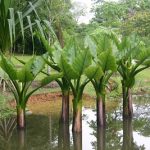Typhonodorum lindleyanum
Uses
Zanzibar (Pemba Island). The tuber is cut into small peces [slices]; placed in a carrying basket (pakacha) and then leached in water – a stream, pond, or in the ocean, to remove highly toxic compounds. The slices also may be repeatedly boiled and then washed in cold water after which they are cooked in coconut juice [sic]. Another processing technique buries the slices in soil or on [in the sand at?] the seashore leaving them for 3 to 4 days, after which they are dug up and washed thoroughly, then spread in the sun to dry. The dried slices are pounded into flour and used for porridge. The seeds are prepared for cooking by rubbing with wood ashes to remove certain toxic matter. After boiling, the seeds for15 to 20 minutes, the water, which has become darkly colored, is poured off and the seeds washed in fresh water and boiled again. This process is repeated twice more, after which the seeds are soft and free from toxic matter. They are then finally prepared for eating, by boiling in coconut juice.
Additional Information
- Name Authority:
- Schott.
- Vernaculars:
- (Kiswahili): [locations]: Ngezi, Kangami, Kiwani, Wete: M)bie: Kangani; Kiwani, Wete: Mtogonya. Kangani: Ngombakofi
